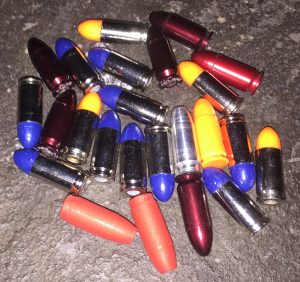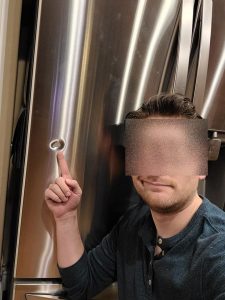 For decades, snap caps were the best option for doing dry fire practice.
For decades, snap caps were the best option for doing dry fire practice.
Because they were the only option.
But, they had some serious shortcomings…
- The more they look like live rounds, the easier it is to mistakenly introduce a live round…with potentially tragic results. It might be that a live round accidentally got mixed in with the snap caps or a magazine that you were doing ball and dummy drills with at the range that still has a dummy round on top and a live round underneath. Regardless, using snap caps for dry fire takes a considerable amount of discipline.
- Dry fire training with a snap cap doesn’t look anything like reality with a semi-auto. Oftentimes, it looks like this…you insert a magazine with multiple snap caps (and no live rounds!) into your pistol, rack the slide, and perform a dry fire rep.Then, you rack the slide.Then, you perform another dry fire rep.
Then, you rack the slide again.
But, unless you rack your slide between each rep during live fire…how’s that realistic?
Somehow…if you do it enough times, your mind is supposed to magically know that it should pay attention to the dry fire reps and ignore racking the slide.But, it doesn’t usually work that way.
What’s much, much more common is that people develop a completely different neural pathway for dry fire than for live fire.
And they slip back into their old bad live-fire habits after the 2nd or 3rd rep at the range.
(ALL of our dry fire training is taught in a way that creates a SINGLE neural pathway for dry fire and live fire…and one of the secrets is interweaving dry fire and live fire [correctly] when you’re at the range doing live fire.)
When snap caps were the only option, they were the best option…but we don’t live in the dark ages anymore. There are better options for semi-autos.
- Snap caps don’t let you do multiple shot strings of fire with semi-autos. If you want to practice 2-to-the-chest and 1-to-the-head with snap caps with a semi-auto…good luck.
Now for live fire, when you load a mag with a majority of snap caps and sprinkle in a couple of live rounds…they’re a great training tool. (But, you never want to do a traditional ball-and-dummy drill if you’re dealing with flinch)
For dry fire, you really do want something in your chamber so that a live round can’t slip in there and end up with an accident like this:

Or worse…
But a snap cap usually isn’t the best answer.
Fortunately, we’re not in the dark ages of dry fire anymore.
There are better (much better) tools for doing at-home dry fire training than snap caps for semi-autos.
You can still use snap caps…you just have to be incredibly disciplined and understand the limits of the effectiveness of the training you’re doing.
But there are GREAT alternatives.
There are laser pistols like the Dry Fire Pistol (SIRT).
You can get an airsoft of your carry gun and do some GREAT training.
I recommend all of these options, but if you’re looking for a MUCH more economical option…one that costs less than a single trip to the range that will allow you to use your own firearm for dry fire training, you really need to check out Dry Fire Cord.
Dry Fire Cord is designed to block your chamber with a quad-chamfered aircraft grade aluminum chamber block as well as give you a visual indicator that the chamber is blocked at both the muzzle and the ejection port.
You don’t have to disassemble your pistol to use it…2-5 seconds to set it up for dry fire, 2-5 seconds to convert your pistol back to live fire. Easy Peasy, Lemon Squeezy.
Dry Fire Cord will positively block the chamber and give you a resetting trigger on a Glock, M&P, Sig, H&K, Kimber, Xd, Walther, and more so that you can practice multiple shot engagements WITHOUT having to rack your slide between reps.
And…it removes the “click” from the trigger press so that you can quickly assess and improve your trigger finger isolation and trigger finger speed. With Dry Fire Cord, you’ll see and know IMMEDIATELY how firmly to grip the gun and how quickly you can run the trigger without disturbing sight alignment.
Learn more and get yours now by clicking >HERE< Normally only available in multi-caliber packs we’ve also got 9mm packs this week!
What about for revolvers? Snap caps are awesome for revolvers. I keep 2 speed loaders handy…an empty one and one filled with snap caps. When it’s time to dry fire, I dump the rounds in the cylinder into the speed loader, insert the snap caps, and do my thing. When it’s time to switch back, I reverse the process.
9 Comments
Grouchy Old Goat
July 21, 2024To Ox, Paul Coker, and others:
It is likely that you can feel the trigger break point, but not the reset point when letting the trigger move forward.
If your trigger doesn’t reset (or you can’t feel the reset), take the tail end of the dry fire cord (that sticks out of the ejection port) and double it over back into the chamber area. That will keep your slide ever so slightly farther out of battery than just letting it dangle out into the open. The result is a different mechanical trigger pull action, and should allow you to feel the trigger reset.
That may seem to logically have no basis in physics or fact, but try it anyway. I had the same issue with my S&W Shield. Because I did not like the end of the dry fire cord ‘dangling’ out of the chamber area (it was interfering with holstering the firearm), I doubled the dangling end over into the chamber and was surprised at the result. Now I have no issue re-holstering, AND I can feel the trigger reset.
How it works I do not know. That would be something for an engineer at S&W, or Canik, or Taurus, or any other firearm manufacturer to explain. All I know is it works. It works so well, even my bride, who dislikes firearms and wants nothing to do with them, can feel the break and reset.
Cheers,
Grouchy Old Goat
Paul Coker
June 13, 2022I currently carry a Canik TP9 Elite SC
When practicing with your dry-fire program, I use a non-extractable snap cap I can feel the point of trigger reset. When I insert the dry-fire cord and the gun is out of battery I can’t detect the reset point during trigger pull. Another anomaly of different arms?
Response to the Snap Cap blog.
Paul
Ox
June 13, 2022I’m not familiar with the Canik. Are you racking the slide between reps when you’re using the non-extractable snap cap?
Bob T
April 2, 2020Small editorial note in the 4th to last paragraph: It currently reads “2-5 seconds to set it up for live fire, 2-5 seconds to convert your pistol back to live fire”. I think you meant “2-5 seconds to set it up for dry fire, 2-5 seconds to convert your pistol back to live fire”. The first live should be dry.
Ox
April 2, 2020That’s not a “small” error…thank you very much for pointing that out!
Vern
December 19, 2019There are still some revolver shooters left in the world. Snap Caps work in them just fine. They don’t weigh as much as a loaded round and off course don’t have any recoil, but the trigger can’t tell the difference.
Ox
December 19, 2019Absolutely…I’m one of those revolver shooters. 🙂
David Harwood
December 18, 2019Your remarks concerning the training scars of a snap cap apply only to the owner of a single action pistol. Any true double action or double-single pistol will let you train multiple-shot scenarios with no problem. My four favorite pistols (Beretta 92, S&W 5926, S&W 4566, Colt Double Eagle) all give me that capability. Just one of the reasons I will not own a Glock.
You totally ignored the Laser Cartridge. It loads into the chamber and makes your (double action) pistol the operational equivalent of a SIRT – allowing you to train with the hand-feel and trigger that you want to be intimately familiar with. It has no extraction rim, so you can also do drills that involve racking the slide. (It has to be poked out of the chamber using a dowel or the eraser end of a pencil.)
Ox
December 18, 2019Hey David,
Thank you for your comments.
The training scars apply to owners of both single action and double action only pistols.
DA/SA pistols have their own set of issues…one of the biggest being that the trigger presses are SO different that you end up needing to practice a lot more to become proficient at both trigger presses. If you do all of your practice in double action mode on a DA/SA pistol, it usually has the impact of making followup shots much slower. Can you train through it? Absolutely–it sounds like you have and I commend you. Does it take more time/effort/discipline? Yes. And in a world where most people who own firearms for self-defense do NO training, I want to encourage them to do as high of leverage of training possible FIRST that will give them the greatest chance of success in a life & death situation.
True double actions…that mimic a revolver trigger press…are another story and I love them. But they are few and far between. Most shooters are going to shoot better sooner by shooting a DAO or single action…that’s what they’re encouraged to buy, that’s what they DO buy, and that’s what they carry and shoot. I don’t write about true double actions for the same reason I don’t write about my favorite pistol…the single action P7…I can help more people by writing about the guns and gear that the majority of people own and use.
You’re right that I ignored laser cartridges. If you fill your cylinders with them, they’re great for revolver practice. If you happen to be shooting a true double action, they’re a great tool. But, again, for DA/SA and DAO, there are issues that you have to identify and train around when you use them.
I hope that makes sense. Sounds like you’ve got stuff figured out for you and I’m glad. Train hard and stay safe.
Leave A Response To Bob T Cancel reply